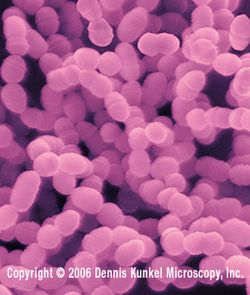Life from the point of view of a freshman in high-school who a) loves vanilla cupcakes b)hates cherry juice c)has a surplus of cow brains laying around
Tuesday, January 11, 2011
T4 Bacteriophage
Streptococcus Mutans
Streptococcus mutans is a type of bacteria called a pathogen. A pathogen is a type of disease producing agent. This particular pathogen causes tooth decay. It is also Gram-positive. This means that when a gram stain is applied to the bacteria, it appears purple. This is because of the peptidoglycan contained in the cell walls. The existence of peptidoglycan in the cell walls renders this type of bacteria a member of the kingdom Eubacteria. Streptococcus mutans’s appearance can be described as scattered and clumped chains of bead-like ovals. It falls under the bacilli shape category. It was first described by JK Clark in 1924 at St. Mary’s hospital in London. He reported that the type of bacteria most frequently found in cavities and most likely to causes tooth decay was Streptococcus mutans. Clark demonstrated that Streptococcus mutans is one of the most virulent decay-producing organisms. This pathogen is commonly found in the human mouth and is a significant contributor to tooth decay. Here’s how it works; sugars such as glucose, fructose, and lactose can be digested by S. mutans and produce lactic acid as an end product. This acid along with plaque is what eventually leads to dental decay. There have been many attempts to create a vaccine against this pathogen. However, no vaccines have been successful in humans. Scientists still have much work to do to fully understand this complex pathogen.
Subscribe to:
Posts (Atom)


